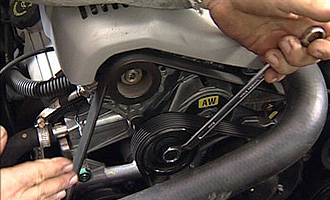| Routine Maintenance | << Back to Education |
Drive Belts & Pipes
Having your car break down is at best inconvenient, but at worst can be very dangerous.
We have therefore created this section to help you keep your car in road worthy condition and reduce the chances of vehicle malfunction.
To find information about how to act if you do breakdown, click here

Drive Belts & Pipes
| Most newer cars require little or no attention to the belts or hoses. You should, however examine them to determine if they are in good working condition. | |
| The place to begin is the radiator (located at the front of the car). Be absolutely positive the engine is cold when examining hoses (or belts). Pay close attention to electric cooling fans, as they can operate without the engine operating. | |
| There are two large hoses attached to the radiator, one at the top and another at the bottom. Both lead to the engine. | |
| With the engine cold, squeeze each hose. If the hose feels brittle, it's old and needs replacing. Examine each hose for cracks, tears or blisters. If they exist, the hose will need replacement. | |
| Next, examine the clamps found on either end of each hose. If the hose is damp or wet in the area of the clamp, tighten the clamp. Each clamp must be sufficiently tight so that the hose cannot be moved (or even turned). | |
| Locate the accessory drive belt(s). They're located between the front of the engine and the radiator. | |
| When examining the belt, look for signs of cracking, fraying or splitting. You should also look for a surface that is hard and appears glazed. | |
| If the belt(s) shows any of the above signs of deterioration, it's time to have the belt replaced. |
© ![]() has compiled this information to be used for educational purposes only
has compiled this information to be used for educational purposes only








